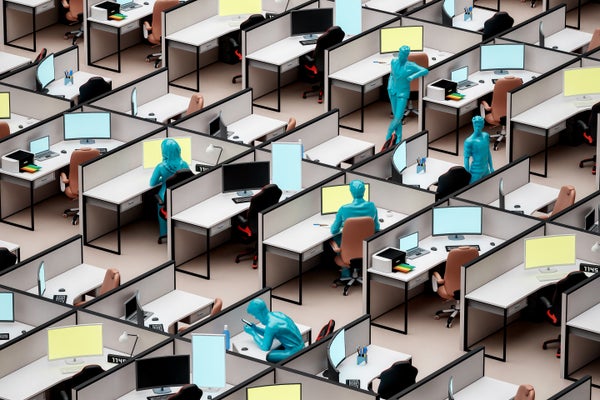October 15, 2024
3 min read
Smart Tech Would Make Your Office Greener
Implementing smart technologies like demand-controlled ventilation could reduce the carbon footprint of office buildings, which contribute over one third of fossil fuel emissions globally

Partially occupied offices consume more fossil fuels than you might think.
Hybrid work is here to stay, leaving office buildings partly deserted. Rather than saving us energy, however, these empty halls and offices keep guzzling fossil fuels and warming our planet. But we can change this collateral damage of working-from-home.
Partly occupied buildings simply do not achieve the expected reductions in energy use. For instance, energy use does not decrease as much as anticipated when buildings are empty in colder climates since their occupants are not present. Why? Because building designs can benefit from heat gains from their occupants. Once their occupants depart, HVAC systems must work harder to compensate for the lack of heat, maintain a baseline temperature and prepare for reoccupancy. All that means more energy consumption.
Partial occupancy is particularly relevant now as teleworking becomes more common post peak pandemic, leading to many empty or partially occupied office buildings. Building operations and construction contribute to over one third of emissions globally, making this infrastructure a good target for energy savings.
On supporting science journalism
If you’re enjoying this article, consider supporting our award-winning journalism by subscribing. By purchasing a subscription you are helping to ensure the future of impactful stories about the discoveries and ideas shaping our world today.
Smart technology is one of the important answers. Around the globe, we should invest in smart building technologies and adopt flexible strategies (such as relaxing thermostat temperatures during partial occupancy) to improve energy efficiency and reduce the carbon footprint of buildings. Smart plugs can help reduce standby devices’ energy consumption and provide remote control. Demand-controlled ventilation (DCV) alters ventilation based on the number of people in a building rather than the assumed full occupancy, resulting in reduced heating load when buildings are partially occupied. According to a study by a team that included one of us, relaxing thermostat setpoints significantly reduces energy consumption in buildings, especially when unoccupied. Carleton researchers also demonstrated that the potential savings from these techs vary from less than 1 percent to more than 25 percent from individual techs; their cumulative savings can range from 5 percent to more than 40 percent based on the climate and the occupancy level.
Reducing energy consumption in buildings directly cuts humans’ carbon footprint, the amount of greenhouse gases they generate daily. Scientists typically report this measurement as CO2e (CO2 equivalent), which represents all greenhouse gases in terms of CO2. Reducing energy use in buildings results in consuming less electricity and heat, which are still widely generated by fossil fuels, to varying degrees around the world. Thus, reducing our carbon footprint would help to mitigate global warming.
Several barriers impede the widespread adoption of smart technologies in buildings. Key challenges include costs and the technological complexity involved in integration. Regulatory and policy limitations, cultural resistance from occupants and managers, interoperability issues with existing systems and concerns about privacy also pose significant obstacles. Addressing these barriers is crucial for harnessing the full potential of smart technologies to reduce energy consumption.
Nevertheless, reducing energy consumption in buildings does not reduce our carbon footprint equally in every country or city, as CO2e for electricity and heat production varies based on how they are generated. For instance, the CO2e per kilowatt-hour (kWh) was 41 grams (g) in Sweden, while it was 381 g/kWh in Germany in 2023.
A final point to consider is that some smart technologies, including smart lighting and plugs, yield higher savings in warmer climates. Additionally, large office buildings can consolidate employees into one area and use strategies like relaxed setpoints in unoccupied rooms to reduce energy use, provided they have appropriate zoning and HVAC design. Other strategies, such as hot-desking and hoteling, can also reduce energy use effectively. When possible, portfolio divestment can also significantly contribute to reducing carbon footprint.
Furthermore, one of the biggest advantages of consolidating occupants in fewer buildings is the potential to sell or repurpose entire buildings, such as converting them into housing. This process can significantly offset the need for new construction, thereby reducing the associated environmental impacts (e.g., use of new concrete and steel).
To achieve maximum savings, we must use smart technologies in all buildings, including homes and offices. Alongside other energy-saving strategies, this tech will mitigate global warming by reducing energy consumption in buildings and CO2e emissions. If we fail to adopt these technologies, buildings will continue to consume excessive energy, exacerbating climate change and increasing operational costs. Using these measures will potentially give scientists, policy makers and other stakeholders more time to come up with solutions or adopt renewable energies for delaying or reversing climate change.
This is an opinion and analysis article, and the views expressed by the author or authors are not necessarily those of Scientific American.
